Walter Anthony Simpson
Walter Anthony Simpson is one of two members of the Canadian forces to fight in the Great War who are commemorated in Dartmouth. Walter is not on the Town Memorial but is commemorated by a family memorial inside St Saviour's church, where his elder brother was the Vicar throughout the war and beyond. Walter's father was a controversial figure in Dartmouth, who was Mayor for ten years and the founder of one of Dartmouth's most important shipbuilding and engineering firms.
Family
Walter Anthony Simpson was born at Maypool, Churston Ferrers, up the river Dart from Dartmouth, on 13th January 1886, and was baptised at St John, Paignton a few weeks later, on 10th February of that year. He was the youngest son and fifth child of Francis Charles Simpson and his wife Marianne Frances Apletre (sometimes spelt Appletree).
Francis Charles Simpson was not a native of Dartmouth. He was born in 1847 in Boynton, Yorkshire, the only son of the Reverend Francis Simpson of Foston Hall, vicar of Boynton and rector of Foston, and his wife Fanny Selina Alexander. He was educated at Eton and Trinity College Cambridge, where he was a member of the Pitt Club, and received his BA degree in 1868. On 3rd April 1872, he married Marianne Frances Apletre, who, after the early death of her brother, became a co-heir of her father and grandfather, inheriting the Goldings estate in Basingstoke and much other property. The marriage, at Basingstoke, was conducted by Francis' father.
Francis and Marianne moved to Dartmouth soon after their marriage - in the Western Times he was recorded in November 1872 at Derwent Lodge, South Town, though the couple also retained Goldings. He made his mark quickly in the town, setting up the Dart Boat Sailing Club with Dartmouth entrepreneur Samuel Lake. He was also soon involved in Dartmouth politics, being elected to the Town Council in November 1874, in what the Exeter and Plymouth Gazette described as a "very quiet" election. Once on the Council, however, he was not quiet. He strongly opposed the proposal to build new Town Council offices to replace the collapsing premises of the Assembly Rooms (built in the seventeenth century on embanked ground which was insufficiently consolidated). He campaigned on the slogan "No more borrowing on the rates" and was able to delay the proposals for some time (eventually in 1878 the Council moved into the Bible Christian Chapel on the New Road).
Meanwhile Francis and Marianne sold Derwent Lodge to Edward Marsh Turnor, father of Percy Edward Turnor (also on our database) and moved into a house on Ridge Hill named Belmont, which they renamed Combecote. The couple's first child, Freda Frances Margaret, was born there on 30th April 1877. She was baptised privately the following day, but sadly died only two days later, being buried on 3rd May at St Clements Townstal.
Francis Simpson established an engine factory at Combecote and the first Kingdon "patent compound engine and boiler", designed by the Kingswear engineer George Kingdon, was assembled in a small shed in the garden. In 1880 the engine factory was transferred to the Redway yard at Sandquay, and together with Joseph Denison (who was recorded in the 1881 Census living with the Simpson family at Combecote) he set up the first boat engine company in Dartmouth, called Simpson and Denison.
In 1881 Dartmouth politics began to be dominated by the proposal to build a new Embankment, to provide access at low water for shipping and a focus for visitors to the town. Francis Simpson strongly objected to the proposal, partly because of the cost and how it would be financed, partly because it would affect his own works, and partly because he had different ideas about how to develop the Harbour. He once again stood for election to the Council, but his nomination, together with other candidates who also opposed the embankment, was declared void on a technicality. He appealed, won the right to fresh elections, and was elected to the Council in April 1882, coming top of the poll, along with his three anti-Embankment colleagues.
Nonetheless the Council voted in favour of starting the scheme and the Dartmouth Harbour Commission began work. In November 1882, in the largest poll ever recorded, four more anti-Embankment councillors were appointed and Francis Simpson was elected Mayor. He led the Council as Mayor for ten years, resolutely opposing the Embankment scheme with a series of law-suits, and refusing to pay the Harbour Commission. The dispute continued long after the work was completed. Eventually in 1891 the Commission agreed a compromise, whereby the Council paid a much-reduced contribution towards the work and received in return the whole of the Embankment, the reclaimed land, and the Boat Float - which had cost the Commission considerably more to build than the Council had paid. Francis Simpson retired as Mayor on 9th November 1892. His successor, William Smith, a solicitor, was the Clerk to the Dartmouth Harbour Commission, and according to the Exeter and Plymouth Gazette of the day after, "his accession to the Mayoralty is looked upon as a reconciliation between all parties in the borough".
Two further children were born to Francis and Marianne while they lived at Combecote: Francis Russell Benedict, in 1880, and Ralph Christopher, in 1883. In that year, Francis commissioned a "mansion on the banks of the Dart over Maypool, Higher Greenway, the memorial stone of which was laid by Master F R B Simpson (3)" (Western Times Friday 31st August 1883). Francis Simpson lived at Maypool until he died in 1923. By the time of the 1891 Census, the couple had five children: Francis Russell Benedict, age 10, Ralph Christopher, age 9, Margaret Noel, age 6, Walter Anthony, age 5, and the youngest, Esther Mary Winifred, age 1 - and also recorded there, to look after them, were a governess, a nurse, and seven other servants.
In 1887 the name of Francis' company was changed to Simpson, Strickland & Co when the partnership with Joseph Denison was dissolved and a new partnership formed with Frederic Strickland, a distant relative. According to Grace's Guide, Frederic Strickland was "a remarkable example of a man whose natural gifts enabled him to devote his career to mechanical engineering, in spite of his never having had the conventional training for the profession". He became the Managing Director of the firm, which grew to become a major shipbuilding and engineering company. In 1890 the firm moved from Sandquay across the Dart to Noss, just upriver from Kingswear. By 1910 they were building boats for seven countries - Britain, India, Italy, Brazil, Belgium, Russia and Argentina; in that year, they launched a yacht for the Prince of Monaco and one for Grand Duke Stephen of Austria; and employed around 300-400 men from in and around the town. (See, for example, Harry Algar and William Richard Stone on our database).
In 1909 Francis Simpson retired from the firm. None of his sons went into the business. After attending Eton and Christ Church, Oxford, Francis Russell chose the church - he was ordained in 1903 and became a curate at Townstal. He married Edith Mary Seale, the only daughter of Sir John Henry Seale, of the Seale family of Mount Boone, Dartmouth, and moved into Combecote, his father's house in Dartmouth. He became the vicar of Dartmouth in 1914, being inducted only a few weeks after the outbreak of war, and served until 1934.
The other two boys were educated at Radley College. Ralph, who left in 1899, chose the Army as his career, and joined the Royal Artillery in 1902, being promoted Lieutenant in 1905. He assumed the surname of Apletre in 1913, after the death of his mother in 1912. Walter also went to Radley, arriving the year after his brother had left. He was recorded there in the 1901 Census, aged 15. He then went up to Trinity Hall, Cambridge in 1904, where he rowed for the College and the University. He was also fined 2s 6d for riding his bicycle without a light in Sidney Street.
Walter chose farming as his career - the 1911 Census recorded him at home in Maypool, with his mother and father, working as a land agent. But evidently, he decided to seek new challenges, for on 6th May 1911 (only a very short time after the Census) he arrived in Quebec on the SS Virginian from Liverpool. His intended destination was Edmonton, Alberta, and his intended occupation, farming, in which he declared he had been employed for one year.
The year after Walter left England, his mother Marianne died at Maypool. Her body was carried on a barge draped in black and accompanied by two similarly covered barges for mourners, towed by a launch to Dartmouth as Simpson, Strickland & Co's workforce lined the foreshore. She was buried at St Clements, Townstal, on 4th December 1912, aged 69.
The Canadian Expeditionary Force
When Britain declared war on Germany, Canada's constitutional position within the British Empire gave the country very little role in formulating foreign policy and no role at all in declaring war or making peace. Canada - like the other Dominions - was thus at war through the action of the British Government. However, Canada reserved the right to decide what form the country's participation should take - and there was little doubt about the position. In January 1910 the then Canadian Prime Minister, Sir Wilfred Laurier, had declared: "When Britain is at war, Canada is at war. There is no distinction". Sir Robert Borden, who was the Prime Minister at the outbreak of war, had expressed himself in similar terms when Leader of the Opposition. A Canadian contingent had been raised for the Boer War, and this set something of a precedent.
Canada had only a very small standing army - at 1st April 1914 the total authorised establishment was 3,110 all ranks and 684 horses. Its main peacetime functions were to garrison fortresses on either coast and assist in training the militia. In contrast, the "Non-Permanent Active Militia" had gradually increased in size and efficiency in the years before the war. By 1st April 1914 its authorised establishment was 74,213 all ranks and 16,726 horses. Mounted rifles units formed a significant element of the militia. They had proved effective in the Boer War - on both sides - and provided mobile firepower at a low cost and in a way which matched many Canadians' sense of themselves as frontiersmen, building on their skills as horsemen and marksmen. Many of the mounted rifles regiments were formed in the western and central provinces.
However, the first contingent of the "Canadian Expeditionary Force" was organised by the Minister of Militia, Sam Hughes, independently of the existing military structure. Instead, volunteers were mobilised at Valcartier, near Quebec, and organised into numbered battalions with little connection to their regional origins. Many members of the militia formed part of this force nevertheless, particularly in the support arms.
The CEF arrived in England during October 1914, and moved to Salisbury Plain for training, where it rapidly encountered conditions of freezing cold, driving rain, and "a sea of mud". Much of the basic Canadian equipment was not suitable and had to be replaced. The 1st Canadian Division embarked for St Nazaire in early February and joined British forces on the Western Front, fighting in many of the major actions of the war.
In the meantime, the Canadian government had decided to raise and send a second contingent of 20,000 men. As part of this contingent, they authorised the raising of four regiments of Canadian Mounted Rifles, partly to satisfy demand from Western Canada for greater participation by mounted troops. Further, after the Ottoman Empire's declaration of war on 31st October 1914, there was an expectation that operations in Egypt and the Middle East, being more mobile, would require mounted troops. Canada therefore raised two Mounted Rifle Brigades, each with three regiments, over the winter of 1914-1915. In the event, however, it was the Australian Light Horse and New Zealand Mounted Rifles which served in the Middle East as mounted rifle formations, after holding the line as infantry at Gallipoli. The Canadian Mounted Rifles found themselves fighting a very different war.
The 3rd Mounted Rifles Regiment was based in Alberta and commanded by Francis Sissons, a horseman and rancher with extensive land holdings around Medicine Hat, in southern Alberta. Subsequently he became the commanding officer of the 1st Canadian Mounted Rifles Brigade. The regiment was authorised on 5th November 1914 to mobilise at Medicine Hat and to draw its recruits from Calgary, Edmonton and Medicine Hat. Recruitment began in mid-December 1914 and the regiment had obtained the majority of its men by the end of January 1915.
Walter evidently responded to this recruitment drive for mounted volunteers, as he signed his attestation papers at Wetaskiwin (about 70 kilometres south of Edmonton) on 31st December 1914. He was not a member of the Active Militia but he had, apparently (the writing is a little difficult to read) previously served in a Canadian infantry unit (though not a mounted unit). He was a farmer, unmarried, and aged just short of 29. He was tall - 5ft 11¼ins - with blue eyes, brown hair, and a "fair" complexion. He gave as his next of kin his father, Francis Simpson, at Maypool, Churston Ferrers.
Initial training for the Mounted Regiments took place in small units, since there were no large training and billeting facilities available, and was based on the assumption that the regiments would be used in the mounted role. Much time was of course spent on stable duties and horse care. In May 1915, however, following severe losses in the 1st Canadian Division at Second Ypres and the Battle of Festubert, it was agreed that the Mounted Regiments would serve on the Western Front as dismounted infantry, though no change was made to their organisation or establishments (which amounted to about 60% of the strength of infantry battalions) since the Mounted Rifle Brigade Commanding Officers wanted to retain their mounted capability. They therefore took their horses with them.
The 3rd CMR Regiment sailed for England on 12th June 1915 and arrived in England seven days later, as part of the 1st Canadian Mounted Rifles Brigade, with the 1st Regiment CMR, who had been recruited in Manitoba and Saskatchewan, and 2nd Regiment CMR, recruited from Vernon and Victoria, British Columbia. Along with many other Canadians, they spent three months in England at Shorncliffe Army Camp near Folkestone, where their training was a little more focussed on the requirements of infantry in trench warfare, including route marches, entrenching, and bomb throwing. The Unit War Diary begins on 1st September 1915 at Shorncliffe, but says little beyond "training and musketry in accordance with Syllabus". On 14th September there was a "Brigade parade with all transport and full marching order". On 19th September the Regiment received verbal orders to move the following day and two advance parties left on 20th September with the horses and wagons. The remainder of the Regiment cleaned up the camp and deposited their wills with the Paymaster.
On 22nd September 1915, 25 officers and 551 other ranks left the camp at 5.20pm, arrived at Folkestone harbour at 6.10pm and were all shipped by 6.30pm. They arrived at Boulogne at 9pm and marched to number 3 Large Rest Camp. By 11.55pm the following day they had arrived at their billets in Bailleul where they met up with the advance parties with the horses and transport. They first went into the trenches at Kortepyp Huts, near Neuve Eglise (now Nieuwkerke), and then moved to "Aldershot Huts", where they were inspected by General Alderson, commanding the Canadian Corps. Most unusually, the War Diary records his criticisms: some men unshaved, absence of entrenching tools in some cases, condition of saddlery and harness, also of transport horses; indicating that all was not well with leadership and training, nor, perhaps, morale.
There was no role for the Mounted Rifle Brigades as such. But instead of receiving more focused training for their role as infantry, for much of October they were used on working parties. On 27th October they were inspected (as part of the Canadian Corps) by the King, who was less critical than General Alderson, sending a message that "he was very pleased with the soldierly bearing of the troops". November continued much the same, with the Regiment based in St Eloi and being sent out on working parties, suffering the occasional casualty and some sickness.
On 22nd November the 3rd CMR Regiment received operational orders to join "Seely's Force", an improvised formation consisting of the Canadian Cavalry Brigade and the two Canadian Mounted Rifle Brigades, under the British officer, Brigadier-General Seely. They were required to defend the extreme southern sector of the line allocated to the Canadian Corps (formed when the 2nd Canadian Division arrived in France), south of Messines, replacing the 2nd Infantry Brigade. On 26th November, the 3rd CMR moved to "Bulford Huts".
Death
While in the line, the 2nd Infantry Brigade had been responsible for a two-battalion raid on German positions across the Douve River, on the night of 15/16th November. They had used portable bridges to cross the river, had cut the German wire, and had seized and held part of the German front line for twenty minutes. They had captured twelve prisoners and inflicted up to fifty casualties. The raid attracted much interest, and Sir John French was keen to see more such operations, rather than what he called the "live and let live" approach to trench warfare.
On the German side, however, the commanders intended to prevent any repeat of this success. They decided to establish an advanced listening post halfway between the German and Canadian line to provide warning of future raids. For this purpose they planned to construct a barrier across the Messines-Ploegsteert Road, which was surrounded by floodwater from the River Douve on both sides.
In the run-up to the night selected for the operation, 1/2nd December, the Canadian trenches were shelled, causing the first serious casualties in the 3rd CMR. On 29th November, enemy shelling killed two and wounded three, though one only slightly. That day, "C" squadron, including Walter, who had been in the regimental reserve, relieved "A" squadron. That night was quiet, but not the following day.
On 1st December, the War Diary reported "enemy lightly shelling the rear of our front line". Between 12noon - 1pm, there was further shelling, but no damage. Then at 2pm, there was a "heavy artillery duel. In the early stages the heavy artillery was paying attention to Brigade and Divisional Headquarters. About 2.30pm Regimental Headquarters, communication trenches, support and front line trenches came under shrapnel and H.E. shell fire which continued until sunset".
Those killed and wounded were listed in the Regiment's War Diary. Walter was one of nine who were killed:
- Captain H S Monkman
- SSM W Bloomer
- Sergt A B McGarry
- Cpl P A Connew
- Pte Rundle Coumbe
- Pte W A Simpson
- Pte A S Waters
- Pte J Bushell
- Pte C Munford
Two officers, one NCO and eight men were wounded. In addition, a shell burst over "A" squadron in reserve, wounding five.
That night the Germans removed the pave blocks from the road behind a fallen tree, and screened by it, built a trench across the road with the stone blocks, with bricks from a nearby cottage, to build a parapet. The Barrier ran across the width of the road and was anchored by strong points on each flank.
Meantime, the heavy shelling and casualties amongst the officers interrupted communications between the regiment and the brigade, and between the brigade and its superiors. Deaths were not reported and Colonel Sissons, commanding the 1st CMR Brigade, made no attempt to contact his headquarters. News of the construction of the Barrier was also not communicated by the 1st CMR Brigade until two days later.
Three separate operations by Seely's Force over the next two weeks were unable to destroy the Barrier. Eventually the 2nd Infantry Brigade was successful on 15th December, in a well-planned attack.
The failure of the Canadian Mounted Rifles in these operations, together with other reported deficiencies, and of course the continuing need for more infantry, rather than mounted troops, led shortly afterward to the breakup of Seely's Force. The Canadian Cavalry Brigade was remounted, and the six Canadian Mounted Rifle regiments were consolidated into four infantry battalions, forming the 8th Brigade of the 3rd Canadian Division. Colonel Sissons was sacked and he resigned his commission, returning to Canada; the commanding officer of the 2nd Canadian Mounted Rifles Brigade, Colonel Smart, was found an appointment in a reserve brigade in England. Several officers transferred out of the CMR, unwilling to convert to infantry. The new 8th Brigade spent a month in instruction before coming back to take over a section of the front.
Some weeks later, the following piece appeared in the Dartmouth Chronicle of 7th January 1916:
The Late Trooper W A Simpson
In a recent issue we recorded the death in France of Trooper Walter Anthony Simpson, Canadian Rifles, third son of Mr F C Simpson, JP, of Maypool.
In the current issue of the Townstal and St Saviours Parish Magazine the Vicar (the Rev F R B Simpson) writes:
"The war touches one especially closely when it carries off one's brother. I know quite well he would not have wished for any other form of death, and I think God could hardly have granted him a finer. He had been back at the base for a week or so, but was requested to join his regiment in the firing line, and joined it shortly before a very heavy bombardment. During this bombardment one of the men was buried under a heap of sand bags, and my brother and a sergeant tried to dig him out, and it was while they were doing this that a shell came and killed them both instantly. It was a hero's death. This is hardly the place to write eulogies of one's own kith and kin. Suffice it to say that one does confer a lasting comfort to those who are left behind in a blessed memory. I thought my readers would like a few details of his death, because so many of you remember him, and I know he had pleasant memories of Dartmouth."
It would seem that the Sergeant killed with Walter was Sergeant McGarry.
Commemoration
Walter was buried in Rosenberg Chateau Military Cemetery, near Ploegsteert. In 1930 all those buried there were exhumed when the owner of the chateau refused to allow them to remain. After the war, the Belgian Government had acquired from the owners the lands on which cemeteries had been constructed, to dedicate them in perpetuity for the purpose - except the Rosenberg chateau, which failed to be secured after prolonged negotiations.
According to the Western Gazette of 14th March 1930, reporting the exhumation:
It is the first time that the Imperial War Graves Commission have met with complete obduracy. The owner of the chateau, which was destroyed during the war, decided to rebuild it. Its original site had been on the crest of a hill, and the cemetery had been laid out on the side of the hill. The owner ... objected to the cemetery on the ground that it destroyed the amenities of the chateau, the windows of which would look down upon it. Every effort was made to persuade him to build elsewhere, to sell the land, or to concede to the dead the place where they had rested for nearly 15 years, but he remained obdurate. Most of the bodies were of men who fell in the Ypres sector in 1915. They included 300 Dominion troops, the remainder being from various home regiments.
Draped with the Union Jack, the coffins were taken to the Berks Cemetery Extension, the location of the Ploegsteert Memorial, and reburied. Walter is buried there, alongside Ambrose McGarry, William Bloomer and Captain Herbert Monkman, who were killed at the same time, and transferred with him.
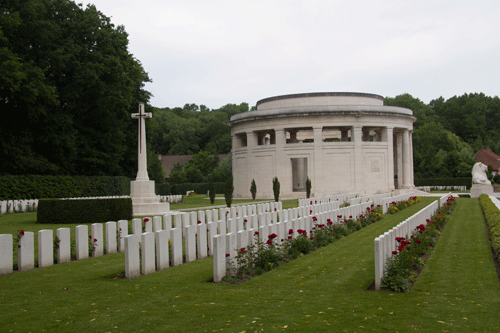

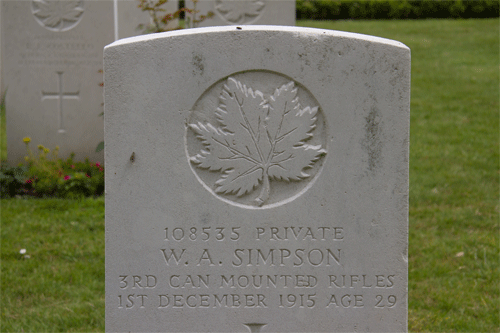
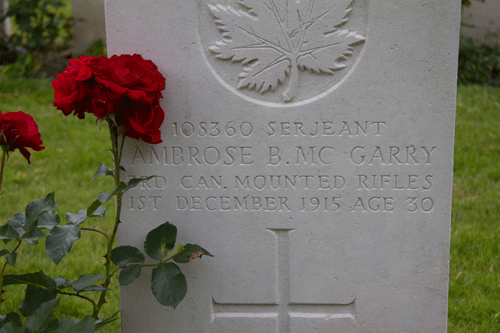

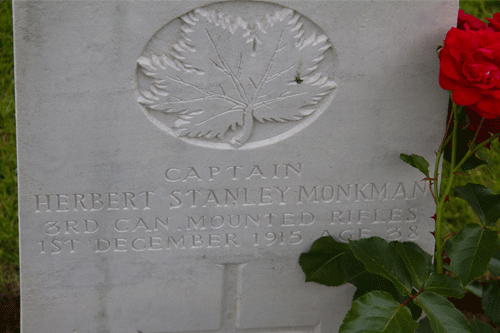
Walter's name does not appear on the Town Memorial in Dartmouth but on the Churston Ferrers village memorial, near Maypool.
In Dartmouth, however, his eldest brother, Reverend F R B Simpson, commissioned a new reredos when the chapel in the south transept of St Saviour was repaired and restored between 1921-1926. The reredos was designed by George Fellows Prynne and was dedicated to the memory of Francis, Marianne and Walter, "who gave his life for his country in the Great War - being killed in action in France 1st December 1915".
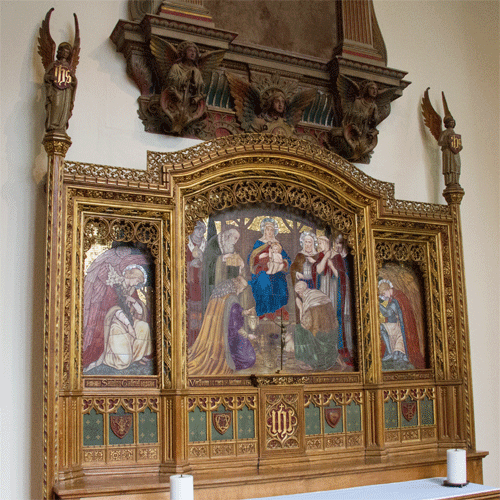

Walter is commemorated on the Canadian Virtual War Memorial and in the Canadian First World War Book of Remembrance.
He is also commemorated in the Trinity Hall Book of Remembrance in the College Chapel, and in the War List of the University of Cambridge, 1914-1918.
A picture of him may be found in the War Memorial section of the Radley College Archives. A brief obituary appeared in The Radleian of February 23rd 1916.
Walter's brother, Ralph, survived the war. According to the Radley College Register, he served in France from 1914-1919, latterly on the Staff. He was wounded and twice mentioned in despatches, and won the Military Cross in 1917.
Sources
Grace's Guide, Simpson Strickland & Co
The Radleian 23rd February 1916
Trinity Hall Book of Remembrance
The War List of the University of Cambridge
Attestation papers available for Walter Anthony Simpson at Library and Archives Canada, "Soldiers of the First World War 1914-1918" database, reference RG 150, Accession 1992-93/166, Box 8932-12, Item number 230913. The service file does not yet appear to be available (digitised files are currently being added to the database).
War Diary for 3rd Regiment Canadian Mounted Rifles accessed online at Library and Archives Canada, online MIKAN number 1883300
First World War Book of Remembrance, page 36
The account of the circumstances of Walter's death draws primarily on "The Barrier and the Damage Done Converting the Canadian Mounted Rifles to Infantry, December 1915", by William Stewart, published in Canadian Military History, Volume 24, Issue 1, Article 31, dated 7th June 2015, accessed online
Other background information from:
Alberta Family Histories Society
Official History of the Canadian Army in the First World War: Canadian Expeditionary Force 1914-1919, by Col G W L Nicholson, CD, published 1962, accessed online
Information Held on Database
| Surname: | Simpson |
| Forenames: | Walter Anthony |
| Rank: | Private |
| Service Number: | 108535 |
| Military Unit: | C Squadron 3rd Regiment Canadian Mounted Rifles |
| Date of Death: | 01 Dec 1915 |
| Age at Death: | 29 |
| Cause of Death: | Killed in action |
| Action Resulting in Death: | Shell fire |
| Place of Death: | Near Ploegsteert, Belgium |
| Place of Burial: | Berks Cemetery Extension, Comines Warneton, Hainaut, Belgium |
| Born or Lived in Dartmouth? | Yes |
| On Dartmouth War Memorial? | No |
| On St Saviour's Memorials? | No |
| On St Petrox Memorials? | No |
| On Flavel Church Memorials? | No |
| In Longcross Cemetery? | No |
| In St Clement's Churchyard? | No |
| On a Private Memorial? | Yes |
| Name of Private Memorial: | Reredos, St Saviour's Church, Dartmouth |
| On Another Memorial? | Yes |
| Name of Other Memorial: | Thurston Ferrers, Radley College, Trinity Hall, Cambridge, Canadian National Memorial |















